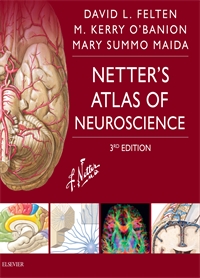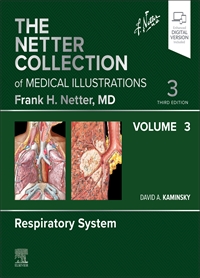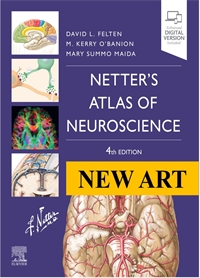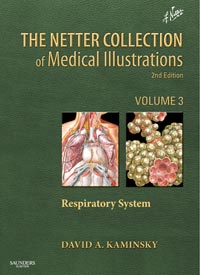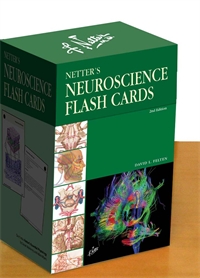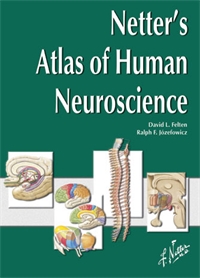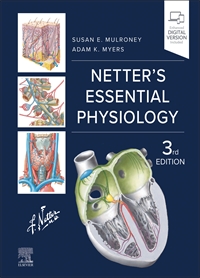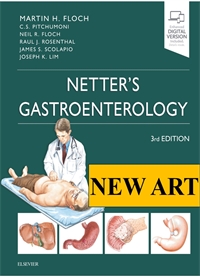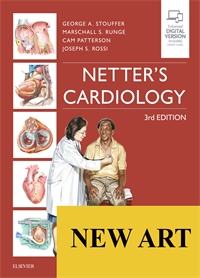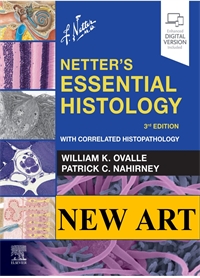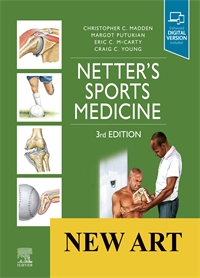Neuroscience - Felten 3rd Edition
Author: David L. Felten, M Kerry O'Banion, Mary Summo Maida
ISBN: 9780323265119
- Page 4: Neuronal Structure
- Page 5: 3D Neuronal Structure and Neurohistology
- Page 6: Types of Synapses
- Page 7: Neuronal Cell Types
- Page 8: Glial Cell Types
- Page 9: Astrocyte Biology
- Page 10: Microglial Biology
- Page 11: Oligodendroglial Biology
- Page 12: Neuronal growth factors and trophic factors
- Page 13: Stem cells in the CNS: Intrinsic and extrinsic mechanisms
- Page 14: Stem Cell Therapy
- Page 15: Blood-Brain Barrier
- Page 16: Inflammation in the CNS
- Page 17: Axonal Transport in the CNS and PNS
- Page 18: Myelination of CNS and PNS Axons
- Page 19: Development of Myelination and Axon Ensheathment
- Page 20: Neuronal Resting Potential
- Page 21: Neuronal Membrane Potential and Sodium Channels
- Page 22: Graded Potentials in Neurons
- Page 23: Mechanisms of excitatory postsynaptic potentials (EPSPs) and inhibitory postsynaptic potentials (IPSPs)
- Page 24: Action Potentials
- Page 25: Propagation of the Action Potential
- Page 26: Conduction Velocity
- Page 27: Classification of Peripheral Nerve Fibers by Size and Conduction Velocity
- Page 28: Electromyography and Conduction Velocity Studies
- Page 29: Presynaptic and Postsynaptic Inhibition
- Page 30: Spatial and Temporal Summation
- Page 31: Normal Electrical Firing Patterns of Cortical Neurons and the Origin and Spread of Seizures
- Page 32: Electroencephalography
- Page 33: Types of electrical discharges in generalized seizures, and sites of action of anti-seizure medications
- Page 34: Visual and Auditory Evoked Potentials
- Page 35: Synaptic Morphology
- Page 36: Mechanisms of Molecular Signaling in Neurons
- Page 37: Neurotransmitter Release
- Page 38: Multiple Neurotransmitter Synthesis, Release, and Signaling from Individual Neurons
- Page 39: Neuronal Signal Transduction: Local Regulation of Synaptic Strength at an Excitatory Synapse
- Page 40: Neuronal Signal Transduction: Regulation of Nuclear Signaling
- Page 41: Glucocorticoid Regulation of Neurons and Apoptosis
- Page 42: Chemical Neurotransmission
- Page 52: Surface Anatomy of the Forebrain: Lateral View
- Page 53: Lateral View of the Forebrain: Functional Regions
- Page 54: Lateral View of the Forebrain: Brodmann's Areas
- Page 55: Anatomy of the Medial (Midsagittal) Surface of the Brain in Situ
- Page 56: Anatomy of the Medial (Midsagittal) Surface of the Brain, with Brain Stem Removed
- Page 57: Medial Surface of the Brain
- Page 58: Anatomy of the Basal Surface of the Brain, with the Brain Stem and -Cerebellum Removed
- Page 59: Basal Surface of the Brain: Functional Areas and Brodmann���s Areas
- Page 60: Brain Imaging: Computed Tomography Scans, Coronal and Sagittal
- Page 61: Brain Imaging: Magnetic Resonance Imaging, Axial and Sagittal T1-Weighted Images
- Page 62: Brain Imaging: Magnetic Resonance Imaging, Axial and Sagittal T2-Weighted Images
- Page 63: Posterior Emission Tomography Scanning
- Page 64: Horizontal Brain Sections Showing the Basal Ganglia
- Page 65: Major Limbic Forebrain Structures
- Page 66: Corpus Callosum
- Page 67: Color Imaging of the Corpus Callosum by Diffusion Tensor Imaging
- Page 68: Hippocampal Formation and Fornix
- Page 69: Thalamic Anatomy
- Page 70: Thalamic Nuclei
- Page 78: Spinal Column: Bony Anatomy
- Page 79: Lumbar Vertebrae: Radiography
- Page 80: Spinal Cord: Gross Anatomy In Situ
- Page 81: The Spinal Cord: Its Meninges and Spinal Roots
- Page 82: Spinal Cord: Cross-Sectional Anatomy In Situ
- Page 83: Spinal Cord White and Gray Matter
- Page 86: Ventricular Anatomy
- Page 87: Ventricular Anatomy in Coronal Forebrain Section
- Page 88: Anatomy of the Fourth Ventricle: Posterior View with Cerebellum Removed
- Page 89: Anatomy of the Fourth Ventricle: Lateral View
- Page 90: Magnetic Resonance Imaging of the Ventricles: Axial and Coronal Views
- Page 91: Circulation of the Cerebrospinal Fluid
- Page 94: Meningeal Arteries: Relationship to Skull and Dura
- Page 95: Arterial Supply to the Brain and Meninges
- Page 96: Common Sites of Cerebrovascular Occlusive Disease
- Page 97: Internal Carotid and Ophthalmic Artery Course
- Page 98: Arterial Distribution to the Brain: Basal View
- Page 99: Arterial Distribution to the Brain: Cutaway Basal View Showing the Circle of Willis
- Page 100: Arterial Distribution to the Brain: Frontal View with Hemispheres Retracted
- Page 101: Arterial Distribution to the Brain: Coronal Forebrain Section
- Page 102: Types of Strokes
- Page 103: Schematic of Arteries to the Brain
- Page 104: Circle of Willis: Schematic Illustration and Vessels In Situ
- Page 105: Arterial Distribution to the Brain: Laterial and Medial Views
- Page 106: Territories of the Cerebral Arteries
- Page 107: Magnetic Resonance Angiography: Frontal and Lateral Views
- Page 108: Angiographic Anatomy of the Internal Carotid Circulation
- Page 109: Vertebrobasilar Arterial System
- Page 110: Angiographic Anatomy of the Vertebrobasilar System
- Page 111: Occlusive Sites of the Vertebrobasilar System
- Page 112: Vascular Supply to the Hypothalamus and the Pituitary Gland
- Page 113: Arterial Blood Supply to the Spinal Cord: Longitudinal View
- Page 114: Anterior and Posterior Spinal Arteries and Their Distribution
- Page 115: Arterial Supply to the Spinal Cord: Cross-Sectional View
- Page 116: Meninges and Superficial Cerebral Veins
- Page 117: Veins: Superficial Cerebral, Meningeal, Diploic, and Emissary
- Page 118: Venous Sinuses
- Page 119: Deep Venous Drainage of the Brain
- Page 120: Deep Venous Drainage of the Brain: Relationship to the Ventricles
- Page 121: Carotid Venograms: Venous Phase
- Page 122: Magnetic Resonance Venography: Coronal and Sagittal Views
- Page 123: Venous Drainage of the Brain Stem and the Cerebellum
- Page 124: Venous Drainage of the Spinal Cord
- Page 126: Formation of the Neural Plate, Neural Tube, and Neural Crest
- Page 127: Neurulation
- Page 128: Neural Tube Development and Neural Crest Formation
- Page 129: Development of Peripheral Axons
- Page 130: Somatic Versus Splanchnic Nerve Development
- Page 131: Limb Rotation and Dermatomes
- Page 132: Neural Proliferation and Differentiation: Walls of the Neural Tube
- Page 133: Neural Tube and Neural Crest Derivatives
- Page 134: Early Brain Development: The 28-Day-Old Embryo
- Page 135: Early Brain Development: The 36-Day-Old Embryo
- Page 136: Early Brain Development: The 49-Day-Old Embryo and the 3-Month-Old Embryo
- Page 137: Forebrain Development: 7 Weeks through 3 Months
- Page 138: The 6-Month and 9-Month Central Nervous Systems
- Page 139: Neurogenesis and Cell Migration in the Developing Neocortex
- Page 140: Comparison of 5-1/2 Week and Adult Central Nervous System Regions
- Page 141: Alar and Basal Plate Derivatives in the Brain Stem
- Page 142: Adult Derivatives of the Forebrain, Midbrain, and Hindbrain
- Page 143: Cranial Nerve Primordia
- Page 144: Cranial Nerve Neuron Components
- Page 145: Development of Motor and Preganglionic Autonomic Nuclei in the Brain Stem and Spinal Cord
- Page 146: Development of the Eye and Orbit
- Page 147: Development of the Ear
- Page 148: Development of the Pituitary Gland
- Page 149: Development of the Ventricles
- Page 150: Development of the Fourth Ventricle
- Page 151: Neural Tube Defects
- Page 152: Defects of the Brain and Skull
- Page 156: Schematic of the Spinal Cord with Sensory, Motor, and Autonomic Components of Peripheral Nerves
- Page 157: Anatomy of a Peripheral Nerve
- Page 158: Nerve Compression and Pressure Gradients
- Page 159: Peripheral Nerve Injury and Degeneration in a Compression Neuropathy
- Page 160: Relationship of Spinal Nerve Roots to Vertebrae
- Page 161: Lumbar Disc Herniation: L4-L5 and L5-S1
- Page 162: Sensory Channels: Reflex and Cerebellar
- Page 163: Sensory Channels: Lemniscal
- Page 164: Motor Channels: Basic Organization of Lower and Upper Motor Neurons
- Page 165: Autonomic Channels
- Page 166: Cutaneous Receptors
- Page 167: Pacinian Corpuscles
- Page 168: Interoceptors
- Page 169: Skin and its Nerves
- Page 170: The Neuromuscular Junction and Neurotransmission
- Page 171: Physiology of the Neuromuscular Junction
- Page 172: Major Structures and Proteins in the Normal Neuromuscular Junction
- Page 173: Neuroeffector Junctions
- Page 174: Dermatomal Distribution
- Page 175: Cutaneous Distribution of Peripheral Nerves
- Page 176: Cutaneous Nerves of the Head and Neck
- Page 177: Cervical Plexus In Situ
- Page 178: Cervical Plexus
- Page 179: Phrenic Nerve
- Page 180: Thoracic Nerves
- Page 181: Brachial Plexus
- Page 182: Dermatomes of the Upper Limb
- Page 183: Cervical Disc Herniation
- Page 184: Cutaneous Innervation of the Upper Limb
- Page 185: The Scapular, Axillary, and Radial Nerves Above the Elbow
- Page 186: Radial Nerve in the Forearm
- Page 187: Musculocutaneous Nerve
- Page 188: Median Nerve
- Page 189: Carpal Tunnel Syndrome
- Page 190: Ulnar Nerve
- Page 191: Lumbar Plexus
- Page 192: Sacral and Coccygeal Plexuses
- Page 193: Femoral and Lateral Femoral Cutaneous Nerves
- Page 194: Obturator Nerve
- Page 195: Sciatic and Posterior Femoral Cutaneous Nerves
- Page 196: Tibial Nerve
- Page 197: Common Peroneal Nerve
- Page 198: General Schema
- Page 199: Autonomic Innervation of the Immune System and Metabolic Organs
- Page 200: Reflex Pathways
- Page 201: Cholinergic and Adrenergic Synapses
- Page 202: Schematic of Cholinergic and Adrenergic Distribution to Motor and Autonomic Structures
- Page 203: Autonomic Distribution to the Head and Neck: Medial View
- Page 204: Autonomic Distribution to the Head and Neck: Lateral View
- Page 205: Schematic of Autonomic Distribution to the Head and Neck
- Page 206: Autonomic Distribution to the Eye
- Page 207: Autonomic Innervation of the Nasal Cavity
- Page 208: Schematic of the Pterygopalatine and Submandibular Ganglia
- Page 209: Schematic of the Otic Ganglion
- Page 210: Innervation of the Limbs
- Page 211: Thoracic Sympathetic Chain and Splanchnic Nerves
- Page 212: Innervatin of the Tracheobronchial Tree
- Page 213: Innervation of the Heart
- Page 214: Abdominal Nerves and Ganglia
- Page 215: Nerves of the Esophagus
- Page 216: Innervation of the Stomach and Proximal Duodenum
- Page 217: Nerves of the Stomach and Duodenum
- Page 218: Innervation of the Small and Large Intestines
- Page 219: Nerves of the Small Intestine
- Page 220: Nerves of the Large Intestine
- Page 221: Enteric Nervous System: Longitudinal View
- Page 222: Enteric Nervous System: Cross-Sectional View
- Page 223: Autonomic Innervation of the Liver and Biliary Tract
- Page 224: Autonomic Innervatin of the Pancreas
- Page 225: Schematic of Innervation of the Adrenal Gland
- Page 226: Innervation of the Adrenal Gland
- Page 227: Autonomic Pelvic Nerves and Ganglia
- Page 228: Nerves of the Kidneys, Ureters, and Urinary Bladder
- Page 229: Innervation of the Kidneys and Upper Ureter
- Page 230: Innervation of the Urinary Bladder and Lower Ureter
- Page 231: Innervation of the Male Reproductive Organs
- Page 232: Innervation of the Femal Reproductive Organs
- Page 234: Cytoarchitecture of the Spinal Cord Gray Matter
- Page 235: Spinal Cord Levels: Cervical, Thoracic, Lumbar, and Sacral
- Page 236: Spinal Cord Levels: Cervical, Thoracic, Lumbar, and Sacral (Continued)
- Page 237: Spinal Cord Levels: Cervical, Thoracic, Lumbar, and Sacral (Continued)
- Page 238: Spinal Cord Levels: Cervical, Thoracic, Lumbar, and Sacral (Continued)
- Page 239: Spinal Cord Histological: Cross Sections
- Page 240: Spinal Cord Histological: Cross Sections (Continued)
- Page 241: Spinal Cord Imaging
- Page 242: Spinal Cord Syndromes
- Page 243: Spinal Cord Lower Motor Neuron Organization and Control
- Page 244: Spinal Somatic Reflex Pathways
- Page 245: Muscle and Joint Receptors and Muscle Spindles
- Page 246: The Muscle Stretch Reflex and Its Central Control Via Gamma Motor Neurons
- Page 248: Brain Stem Cross-Sectional Anatomy: Section 1
- Page 249: Brain Stem Cross-Sectional Anatomy: Section 2
- Page 250: Brain Stem Cross-Sectional Anatomy: Section 3
- Page 251: Brain Stem Cross-Sectional Anatomy: Section 4
- Page 252: Brain Stem Cross-Sectional Anatomy: Section 5
- Page 253: Brain Stem Cross-Sectional Anatomy: Section 6
- Page 254: Brain Stem Cross-Sectional Anatomy: Section 7
- Page 255: Brain Stem Cross-Sectional Anatomy: Section 8
- Page 256: Brain Stem Cross-Sectional Anatomy: Section 9
- Page 257: Brain Stem Cross-Sectional Anatomy: Section 10
- Page 258: Brain Stem Cross-Sectional Anatomy: Section 11
- Page 259: Brain Stem Cross-Sectional Anatomy: Section 12
- Page 260: Brain Stem Cross-Sectional Anatomy: Section 13
- Page 261: Brain Stem Cross-Sectional Anatomy: Section 14
- Page 262: Brain Stem Arterial Syndromes
- Page 263: Cranial Nerves: Schematic of Distribution of Sensory, Motor, and Autonomic Fibers
- Page 264: Cranial Nerves and Their Nuclei: Schematic View From Above
- Page 266: Cranial Nerves and Their Nuclei: Schematic Lateral View
- Page 267: Nerves of the Orbit
- Page 268: Nerves of the Orbit (Continued)
- Page 269: Extraocular Nerves (III, IV, and VI) and the Ciliary Ganglion: View in Relation to the Eye
- Page 270: Trigeminal Nerve (V)
- Page 272: Innervation of Teeth
- Page 273: Facial Nerve (VII)
- Page 274: Facial Nerve Branches and the Parotid Gland
- Page 275: Vestibulocochlear Nerve (VIII)
- Page 276: Glossopharyngeal Nerve (IX)
- Page 277: Accessory Nerve (XI)
- Page 278: Vagus Nerve (X)
- Page 280: Hypoglossal Nerve (XII)
- Page 281: Reticular Formation: General Pattern of Nuclei in the Brain Stem
- Page 282: Reticular Formation: Nuclei and Areas in the Brain Stem and Diencephalon
- Page 283: Major Afferent and Efferent Connections to the Reticular Formation
- Page 284: Sleep-Wakefulness Control
- Page 285: Cerebellar Organiation: Lobes and Regions
- Page 286: Cerebellar Anatomy: Lobules
- Page 287: Cerebellar Anatomy: Deep Nuclei and Cerebellar Peduncles
- Page 290: Thalamic Anatomy and Interconnections with the Cerebral Cortex
- Page 291: Hypothalamus and Pituitary Gland
- Page 292: Hypothalamic Nuclei
- Page 296: A. Axial (Horiontal) Sections Through the Forebrain: Level 1 - Mid Pons
- Page 297: B. Axial (Horiontal) Sections Through the Forebrain: Level 1 - Mid Pons
- Page 298: A. Axial (Horiontal) Sections Through the Forebrain: Level 2 - Rostral Pons
- Page 299: B. Axial (Horiontal) Sections Through the Forebrain: Level 1 - Mid Pons
- Page 300: A. Axial (Horiontal) Sections Through the Forebrain: Level 2 - Rostral Pons
- Page 301: B. Axial (Horiontal) Sections Through the Forebrain: Level 2 - Rostral Pons (Continued)
- Page 302: A. Axial (Horizontal) Sections Through the Forebrain: Level 3 - Midbrain
- Page 303: B. Axial (Horizontal) Sections Through the Forebrain: Level 3 - Midbrain (Continued)
- Page 304: A. Axial (Horizontal) Sections Through the Forebrain: Level 4 - Rostral Midbrain and Hypothalamus
- Page 305: B. Axial (Horizontal) Sections Through the Forebrain: Level 5 - Anterior Commissure and Caudal Thalamus (Continued)
- Page 306: A. Axial (Horizontal) Sections Through the Forebrain: Level 6 - Head of Caudate and Mid Thalamus
- Page 307: B. Axial (Horizontal) Sections Through the Forebrain: Level 6 - Head of Caudate and Mid Thalamus
- Page 308: A. Axial (Horizontal) Sections Through the Forebrain: Level 7 - Basal Ganglia and Internal Capsule
- Page 309: B. Axial (Horizontal) Sections Through the Forebrain: Level 7 - Basal Ganglia and Internal Capsule (Continued)
- Page 310: A. Axial (Horizontal) Sections Through the Forebrain: Level 8 - Dorsal Caudate, Splenium, and Genu of Corpus Callosum
- Page 311: B. Axial (Horizontal) Sections Through the Forebrain: Level 8 - Dorsal Caudate, Splenium, and Genu of Corpus Callosum (Continued)
- Page 312: A. Axial (Horizontal) Sections Through the Forebrain: Level 9 - Body of Corpus Callosum
- Page 313: B. Axial (Horizontal) Sections Through the Forebrain: Level 9 - Body of Corpus Callosum (Continued)
- Page 314: A. Axial (Horizontal) Sections Through the Forebrain: Level 10 - Centrum Semiovale
- Page 315: B. Axial (Horizontal) Sections Through the Forebrain: Level 10 - Centrum Semiovale (Continued)
- Page 316: A. Coronal Sections Through the Forebrain: Level 1 - Genu of Corpus Callosum
- Page 317: B. Coronal Sections Through the Forebrain: Level 1 - Genu of Corpus Callosum (Continued)
- Page 318: A. Coronal Sections Through the Forebrain: Level 2 - Head of Caudate Nucleus and Nucleus Accumbens
- Page 319: B. Coronal Sections Through the Forebrain: Level 2 - Head of Caudate Nucleus and Nucleus Accumbens (Continued)
- Page 320: A. Coronal Sections Through the Forebrain: Level 3 - Anterior Commissure and Columns of Fornix
- Page 321: B. Coronal Sections Through the Forebrain: Level 3 - Anterior Commissure and Columns of Fornix (Continued)
- Page 322: A. Coronal Sections Through the Forebrain: Level 4 - Amygdala, Anterior Limb of Internal Capsule
- Page 323: B. Coronal Sections Through the Forebrain: Level 4 - Amygdala, Anterior Limb of Internal Capsule (Continued)
- Page 324: A. Coronal Sections Through the Forebrain: Level 5 - Mammillary Body
- Page 325: B. Coronal Sections Through the Forebrain: Level 5 - Mammillary Body (Continued)
- Page 326: A. Coronal Sections Through the Forebrain: Level 6 - Mammillothalamic Tract and Substantia Nigra, Rostral Hippocampus
- Page 327: B. Coronal Sections Through the Forebrain: Level 6 - Mammillothalamic Tract and Substantia Nigra, Rostral Hippocampus (Continued)
- Page 328: A. Coronal Sections Through the Forebrain: Level 7 - Midthalamus
- Page 329: B. Coronal Sections Through the Forebrain: Level 7 - Midthalamus (Continued)
- Page 330: A. Coronal Sections Through the Forebrain: Level 8 - Geniculate Nuclei
- Page 331: B. Coronal Sections Through the Forebrain: Level 8 - Geniculate Nuclei (Continued)
- Page 332: A. Coronal Sections Through the Forebrain: Level 9 - Caudal Pulvinar and Superior Colliculus
- Page 333: B. Coronal Sections Through the Forebrain: Level 9 - Caudal Pulvinar and Superior Colliculus (Continued)
- Page 334: A. Coronal Sections Through the Forebrain: Level 10 - Splenium of Corpus Callosum
- Page 335: B. Coronal Sections Through the Forebrain: Level 10 - Splenium of Corpus Callosum (Continued)
- Page 336: Layers of the Cerebral Cortex
- Page 337: Cortical Neuronal Cell Types
- Page 338: Vertical Columns: Functional Units of the Cerebral Cortex
- Page 339: Efferent Connections of the Cerebral Cortex
- Page 340: Neuronal Origins of Efferent Connections of the Cerebral Cortex
- Page 341: Cortical Association Pathways
- Page 342: Major Cortical Association Bundles
- Page 343: Color Imaging of Association Pathways
- Page 344: Color Imaging of Projection Pathways From the Cerebral Cortex
- Page 345: Functional Magnetic Resonance Imaging
- Page 346: Aphasias and Cortical Areas of Damage
- Page 347: Noradrenergic Pathways
- Page 348: Serotonergic Pathways
- Page 349: Dopaminergic Pathways
- Page 350: Central Cholinergic Pathways
- Page 351: Distribution of Pathology in the Brain in Alzheimer Disease
- Page 352: The Olfactory Nerve and Nerves of the Nose
- Page 356: Somatosensory Afferents to the Spinal Cord
- Page 357: Spinal Somatic Reflex Actions and Pathways
- Page 358: Somatosensory System: Spinocerebellar Pathways
- Page 359: Somatosensory System: The Dorsal Column System and Epicritic Modalities
- Page 360: Somatosensory System: The Spinothalamic and Spinoreticular Systems and Protopathic Modalities
- Page 362: Spinothalamic and Spinoreticular Nociceptive Processing in the Spinal Cord
- Page 363: Mechanisms of Neuropathic Pain and Sympathetically Maintained Pain
- Page 364: Descending Control of Ascending Somatosensory Systems
- Page 365: Trigeminal Sensory and Associated Sensory Systems
- Page 366: Pain-Sensitive Structures of the Head and Pain Referral
- Page 367: Anatomy of Taste Buds and Their Receptors
- Page 368: Taste Pathways
- Page 369: Peripheral Pathways for Sound Reception
- Page 370: Bony and Membranous Labyrinths
- Page 371: VIII Nerve Innervation of Hair Cells of the Organ of Corti
- Page 372: Cochlear Receptors
- Page 373: Afferent Auditory Pathways
- Page 374: Afferent Auditory Pathways (Continued)
- Page 375: Centrifugal (Efferent) Auditory Pathways
- Page 376: Vestibular Receptors
- Page 377: Vestibular Pathways
- Page 378: Nystagmus
- Page 379: Anatomy of the Eye
- Page 380: Anterior and Posterior Chambers of the Eye
- Page 381: The Retina: Retinal Layers
- Page 382: The Retina: Photoreceptors
- Page 383: The Retina: Optic Nerve
- Page 384: Arteries and Veins of the Eye
- Page 385: Anatomy and Relations of Optic Chiasm
- Page 386: Visual Pathways: Retinal Projections to the Thalamus, Hypothalamus, and Brain Stem
- Page 387: Pupillary Light Reflex
- Page 388: Visual Pathway: The Retino-Geniculo-Calcarine Pathway
- Page 389: Visual Pathways in the Parietal and Temporal Lobes
- Page 390: Visual System Lesions
- Page 392: Alpha and Gamma Lower Motor Neurons
- Page 393: Distribution of Lower Motor Neurons in the Spinal Cord
- Page 394: Distribution of Lower Motor Neurons in the Brain Stem
- Page 395: Cortical Efferent Pathways
- Page 396: Color Imaging of Cortical Efferrent Pathways
- Page 397: Corticobulbar Tract
- Page 398: Corticospinal Tract
- Page 400: Corticospinal Tract Terminations in the Spinal Cord
- Page 401: Rubrospinal Tract
- Page 403: Vestibulospinal Tracts
- Page 404: Reticulospinal and Corticoreticular Pathways
- Page 405: Tectospinal Tract and Interstitiospinal Tract
- Page 406: Spinal Cord Terminations of Major Descending Upper Motor Neuron Tracts
- Page 407: Central Control of Eye Movements
- Page 408: Central Control of Respiration
- Page 409: Functional Subdivisions of the Cerebellum
- Page 410: Cerebellar Neuronal Circuitry
- Page 411: Circuit Diagrams of Afferent Connections in the Cerebellum
- Page 412: Afferent Pathways to the Cerebellum
- Page 413: Cerebellar Efferent Pathways
- Page 414: Cerebellovestibular and Vestibulocerebellar Pathways
- Page 415: Schematic Diagrams of Efferent Pathways from the Cerebellum to Upper Motor Neuronal Systems
- Page 416: Connections of the Basal Ganglia
- Page 417: Simplified Schematic of Basal Ganglia Circuitry and Neurochemistry
- Page 418: Parallel Loops of Circuitry Through the Basal Ganglia
- Page 419: Connections of Nucleus Accumbens
- Page 422: General Organization of the Autonomic Nervous System
- Page 424: General Anatomy of the Hypothalamus
- Page 425: Sections Through the Hypothalamus: Preoptic and Supraoptic Zones
- Page 426: Sections Through the Hypothalamus: Tuberal Zone
- Page 427: Sections Through the Hypothlamus: Mammillary Zone
- Page 428: Schematic Reconstruction of the Hypothalamus
- Page 429: Forebrain Regions Associated with the Hypothalamus
- Page 430: Afferent and Efferent Pathways Associated with the Hypothalamus
- Page 431: Schematic Diagram of Major Hypothalamic Afferent Pathways
- Page 432: Schematic Diagram of Major Hypothalamic Efferent Pathways
- Page 433: Summary of General Hypothalamic Connections
- Page 434: Paraventricular Nucleus of the Hypothalamus: Regulation of Pituitary Neurohormonal Outflow, Autonomic Preganglionic Outflow, and Limbic Activity
- Page 435: Mechanisms of Cytokine Influences on the Hypothalamus and Other Brain Regions and on Behavior
- Page 436: Circumventricular Organs
- Page 437: The Hypophyseal Portal Vasculature
- Page 439: Regulation of Anterior Pituitary Hormone Secretion
- Page 440: Posterior Pituitary (Neurohypophyseal) Hormones: Oxytocin and Vasopressin
- Page 441: Vasopressin (Antidiuretic Hormone) Regulation of Water Balance and Fluid Osmolality
- Page 442: The Hypothalamus and Thermoregulation
- Page 443: Hypothalamic Regulation of Cardiac Function
- Page 444: Short-Term Regulation of Blood Pressure
- Page 445: Long-Term Regulation of Blood Pressure
- Page 446: Neural Control of Appetite and Hunger
- Page 447: Signaling Systems Involved in Regulation of Food Intake, Body Weight, and Metabolism
- Page 448: Neural and Neuroendocrine Roles in the Fight-Or-Flight Response
- Page 449: Neuroimmunomodulation
- Page 450: Anatomy of the Limbic Forebrain
- Page 451: Hippocampal Formation: General Anatomy
- Page 452: Neuronal Connections in the Hippocampal Formation
- Page 453: Major Afferent and Efferent Connections of the Hippocampal Formation
- Page 454: Afferent and Efferent Connections of the Entorhinal Cortex
- Page 455: Major Afferent Connections of the Amygdala
- Page 456: Major Efferent Connections of the Amygdala
- Page 457: Summary of Major Afferents, Efferents, and Interconnections of the Amygdala
- Page 458: Major Afferent and Efferent Connections of the Septal Nuclei
- Page 459: Major Connections of the Cingulate Cortex
- Page 460: Olfactory Receptors
- Page 461: Olfactory Pathways
